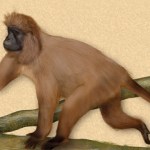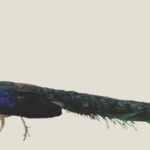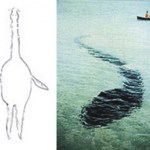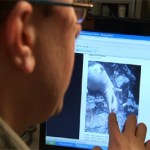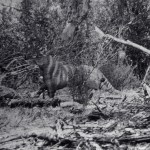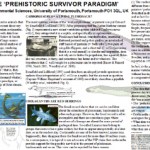cryptozoology
An artist’s reconstruction of the kipunji (Lophocebus kipunji), drawn from a research video shot in the Ndundulu Forest in southern Tanzania and officially described in 2003. Image fromNATIONAL SCIENCE FOUNDATION
I just read an interesting article published in The Scientist today about cryptozoology, a field of research specializing in the study of animals about which only anecdotal or partial evidence exists. In other words, no actual specimens have been studied...think Big Foot or the Loch Ness Monster. There is now a new peer-reviewed scientific journal, The Journal of Cryptozoology,…
A friend of mine told me this story: As a special forces soldier, a Green Beret, he was alone and traveling through a dense area of jungle in or near Viet Nam during the 1960s. Enemy soldiers were nearby and he intended to pass through their patrol area to arrive at some safe destination, but he fully expected to run into a trip wire, a sentry, or a squadron of hostiles. His rifle was loaded and ready to fire at any moment.
Suddenly, a figure loomed in front of him. Without waiting for even a fraction of a second, he fired on it with lethal effect. The figure fell to the floor of the jungle…
On July 12th 2011 a very interesting thing is happening - interesting, that is, if you're interested in the academic evaluation of cryptozoological data. ZSL (the Zoological Society of London) is hosting the meeting 'Cryptozoology: science or pseudoscience?'. Speakers are Charles Paxton, Michael Woodley and myself. Henry Gee is acting as chair.
Given that one of the things we hope to address is whether cryptozoology - whatever that term might mean - should be considered a valid branch of zoological science, this meeting shouldn't be taken as evidence that cryptozoology has finally "come in…
On May 24th 2011, photographer Mark Harrison took a few photos of the large marine creature he saw off the Wirral Peninsula, near Liverpool (UK). Harrison initially thought that the animal might be a seal, but then decided to put the photos online as a sort of joke. Several newspapers then ran the photos as depicting a "sea monster" - dubbed the "Mersey monster" - that "baffles marine experts". Most of the coverage has appeared in the Liverpool Echo. So - OMG! - a new sea monster photographed!! Can we ever solve this most mysterious monster mystery??!? Well, duh.
The Liverpool Echo…
On March 14th 2011 National Geographic screened episode 1 of their new series Wild Case Files (here in the UK, the episode was screened on April 11th), and the reason I'm writing about it is because I featured in said episode.
The first section of the show was devoted to an investigation of the 'Montauk monster'. They provided a potted history of the whole 'Montauk monster' story, spoke to all the main characters involved, and ended with me explaining how the carcasses (both the original, July 2008 specimen, and the 'Clapsadle carcass' of May 2009 and 'Gurney's Inn monster' of September…
I don't do requests on Tet Zoo, but when enough people ask me about the same thing it does get into my head. Ever since the early days of ver 1 people have been asking me about late-surviving sivatheres. What, they ask, is the deal with those various pieces of rock art and that Sumerian figurine - discovered in Iraq - that apparently depict Sivatherium? As most of you will know, Sivatherium was a large, short-necked giraffid, originally described for S. giganteus from the Siwalik Hills of India [shown below in a well-known and oft-used illustration by Michael R. Long*] but later discovered…
PLEASE NOTE (ADDED 2012): IT SHOULD BE EXTREMELY OBVIOUS THAT THIS ARTICLE IS AN APRIL FOOL'S JOKE, NOT A DESCRIPTION OF REAL RESEARCH.
Today sees the publication of what is surely the century's most significant zoological discovery. After decades of searching, Africa's mystery Congolese swamp monster, the Mokele-Mbembe, has been discovered - it is a living sauropod dinosaur, and it radically alters our understanding of archosaur phylogeny, sauropod biology and diversity, and indeed the evolutionary process as a whole.
As is fitting for the discovery of a brand new, extant, hitherto…
Well, the whole 'distributed denial of service' thing has done a pretty effective job of keeping me away from Tet Zoo entirely. No chance to blog, and not even the chance to look at the site at all - so, wow, thanks for keeping the protobats discussion going (97 98 comments... not bad). While those jolly nice people at ScienceBlogs tech support have just unblocked my IP address, it seems that lots of readers remain blocked - I see Tet Zoo sliding down the ratings a bit over on Nature Blog Network. Yikes, fifth place! Anyway, I'm just about ready to start deluging Tet Zoo with the enormous…
It seems wrong not to talk, at least briefly, about the latest lake monster picture that's doing the rounds. It's a poor-quality mobile phone photo of a humped object, taken in England's Lake Windermere by Tom Pickles while he was kayaking as part of a team-building exercise. Here it is... (or, rather, here is the uncropped image... read on)...
Pickles described the object as "a giant dark brown snake with humps measuring three car lengths", and regarded it as somewhat seal-like in skin texture but with a "completely abnormal" shape.
Apparently, it moved rapidly, with an undulating motion.…
Today, my friends, is January 21st 2011. Do you know what this means? It means (drumroll)... that Tet Zoo is five years old today. Wow. Five years. With apologies to those who've heard the story before, things started in 2006 over at blogspot, and in 2007 Tet Zoo ver 2 kicked off here on ScienceBlogs. So: happy birthday Tet Zoo!
The fact that I've now been blogging about hardcore zoology for five years is a little scary; it makes me worried that things here might have become stale or blasé. To be honest, if that's so I haven't noticed and, anyway, my motivations for blogging are almost…
Photos purported to show 'mystery animals' are always great fun. One of the most perplexing and curious of the lot was taken on a box Brownie camera near Goroke, western Victoria, Australia, in 1964. I'm referring, of course, to Rilla Martin's photo of a strange, striped, running mammal.
This photo has generally become known as 'the Ozenkadnook tiger photo'; in fact, the term 'Ozenkadnook tiger' was and is used for a supposed mystery beast (suspected by witnesses and locals to be a mainland Thylacine Thylacinus cynocephalus) seen since the 1880s across southwestern Victoria and southeastern…
Yet another 'sea monster carcass' was brought to my attention recently (thanks Paul), and in the interests of tradition and of bringing it to a wider audience I thought I should include it here (I'm very late to the party: Cryptomundo discussed the case when it broke three years ago). Dubbed the 'Conakry Monster', it washed up on the coast of Guinea in May 2007. It was described as being a gigantic crocodile/lizard monster with an armoured back, fur, a long tail and 'four paws'! The blackened surface to the skin led some people to think that it might have been burnt... somehow.
The Russian…
Yet again, a waterlogged, partially decomposed mammal carcass has become "an internet sensation" (to quote the popular media), and yet again people are saying it might be a new 'Montauk monster', or a Chupacabras, or a relative of Nessie, or Ogopogo, or a baby sasquatch, or some other sort of ungodly monster. The back-story is that the carcass was pulled from the water of Big Trout Lake near the community of Kitchenuhmaykoosib Inninuwug, Ontario, earlier in May this year. It's a rather small (30 cm total length), dark-brown mammal carcass that's lacking hair on its face and at least one of…
This weekend (17th-18th April 2010), the 9th European Symposium of Cryptozoology is being held at Engreux in the south of Belgium. I meant to attend and give a talk, but had to cancel for financial reasons. And it's just as well that I did, given that virtually all flights from out of the UK have been cancelled due to the Icelandic eruption (the consequences of this eruption are interesting: the sky here in England is free of planes and contrails, and a very fine covering of ash covers cars and other objects). Anyway, my non-attendance in person meant that I was invited to submit a poster…
Like many people interested in cryptozoology (the study of animals - or alleged animals - known only from anectodal evidence), I'm of the opinion that the Australian Yowie is one of the most problematic of mystery beasts. It is, in fact, so ridiculous and inconvenient that it's difficult to take seriously. As if sasquatch, yeti and orang pendek aren't difficult enough*, what are we to make of antipodean reports of a hairy, bipedal, ape-like creature? Back in 2006 (oh my god, four years ago already), Tony Healy and Paul Cropper collated everything known about the Yowie for their book The…
More thoughts on the ZSL meeting 'The Secret World of Naked Snakes', held on Monday 7th December. In the previous article I discussed Mark Wilkinson and David Gower's presentations [for relevance of pic used above, read on].
Alexander Kupfer was up next, and provided an excellent overview of reproductive diversity, viviparity and parental care in caecilians (his talk was titled 'Yummy mummy: skin feeding and caecilian reproductive biology') [images above, from Wilkinson et al. (2008), show mother Siphonops annulatus looking after, and feeding, babies]. Caecilians exhibit five different…
Goddammit, no time for more reports from Libya, or for more in the toads series, or for articles on hairless Spectacled bears or tiny heterodontosaurids or neovenatorids, or anything really. Here's how things are progressing in view of Saturday's event...
Well done if you can work out what the hell's going on here. I know that some of you can.
On November 7th 2009, the Centre For Inquiry in London is hosting a one-day event titled Monsters From the Deep! It's being held at Conway Hall in Red Lion Square (a venue I know all too well...). I'm giving a talk at the event so wanted to advertise it: for more details please visit the CFI website here. The day kicks off at 11am and will include both talk and workshop sessions. Charles Paxton of the University of St. Andrews, well known for his work on statistical ecology, will be giving a talk titled 'Anecdotes, statistics and sea monsters'. The belief that anecdotal data (in this case,…
One of the most famous of 'missing' birds is the elusive Night parrot, an obscure nocturnal species discovered by John McDouall Stuart in 1845 (though not named until 1861). Small, reluctant to fly, highly nomadic and cryptically coloured, it's never been well known and even now there are only 23 or so specimens in collections. You might know the Night parrot as Geopsittacus occidentalis but many ornithologists now regard it as so close to the Ground parrot Pezoporus wallicus that both are included within the same genus (and Pezoporus Illiger, 1811 is older than Geopsittacus Gould, 1861).
By…
As you'll know if you're familiar with the literature on the Loch Ness monster - and as you won't if you're not - Nessie is not only seen in the water; there are, in fact, quite a few claimed sightings that were made on land. The most interesting thing about these accounts is that they're radically divergent, and it would seem that all manner of surreal giant monsters lurk in the bushes and woods around the loch. Here are a few of my favourites.
In 1932 Colonel Fordyce and his wife reported a shaggy-furred, long-legged, long-necked camel-like creature (shown above). It crossed a road to get…
